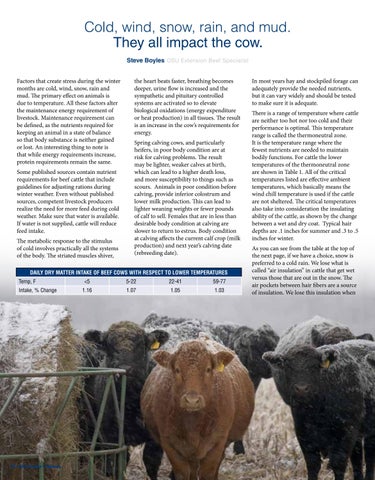Cold, wind, snow, rain, and mud. They all impact the cow. Steve Boyles OSU Extension Beef Specialist Factors that create stress during the winter months are cold, wind, snow, rain and mud. The primary effect on animals is due to temperature. All these factors alter the maintenance energy requirement of livestock. Maintenance requirement can be defined, as the nutrients required for keeping an animal in a state of balance so that body substance is neither gained or lost. An interesting thing to note is that while energy requirements increase, protein requirements remain the same. Some published sources contain nutrient requirements for beef cattle that include guidelines for adjusting rations during winter weather. Even without published sources, competent livestock producers realize the need for more feed during cold weather. Make sure that water is available. If water is not supplied, cattle will reduce feed intake. The metabolic response to the stimulus of cold involves practically all the systems of the body. The striated muscles shiver,
the heart beats faster, breathing becomes deeper, urine flow is increased and the sympathetic and pituitary controlled systems are activated so to elevate biological oxidations (energy expenditure or heat production) in all tissues. The result is an increase in the cow’s requirements for energy. Spring calving cows, and particularly heifers, in poor body condition are at risk for calving problems. The result may be lighter, weaker calves at birth, which can lead to a higher death loss, and more susceptibility to things such as scours. Animals in poor condition before calving, provide inferior colostrum and lower milk production. This can lead to lighter weaning weights or fewer pounds of calf to sell. Females that are in less than desirable body condition at calving are slower to return to estrus. Body condition at calving affects the current calf crop (milk production) and next year’s calving date (rebreeding date).
DAILY DRY MATTER INTAKE OF BEEF COWS WITH RESPECT TO LOWER TEMPERATURES Temp, F Intake, % Change
76 • Cow Country • February
<5
5-22
22-41
59-77
1.16
1.07
1.05
1.03
In most years hay and stockpiled forage can adequately provide the needed nutrients, but it can vary widely and should be tested to make sure it is adequate. There is a range of temperature where cattle are neither too hot nor too cold and their performance is optimal. This temperature range is called the thermoneutral zone. It is the temperature range where the fewest nutrients are needed to maintain bodily functions. For cattle the lower temperatures of the thermoneutral zone are shown in Table 1. All of the critical temperatures listed are effective ambient temperatures, which basically means the wind chill temperature is used if the cattle are not sheltered. The critical temperatures also take into consideration the insulating ability of the cattle, as shown by the change between a wet and dry coat. Typical hair depths are .1 inches for summer and .3 to .5 inches for winter. As you can see from the table at the top of the next page, if we have a choice, snow is preferred to a cold rain. We lose what is called “air insulation” in cattle that get wet versus those that are out in the snow. The air pockets between hair fibers are a source of insulation. We lose this insulation when






















